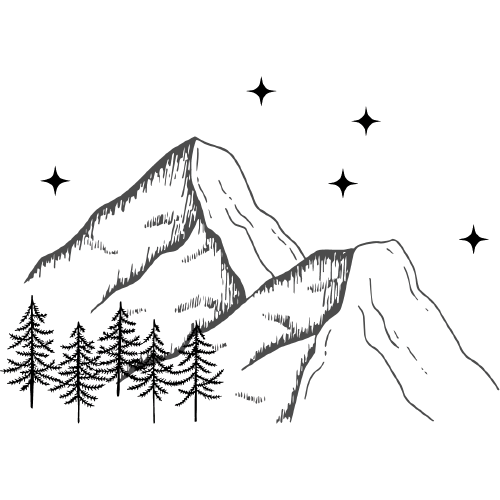Driving Through Joshua Tree National Park: Things to See in One Day
Driving through Joshua Tree National Park can be a great way to see the park’s highlights in a day.
Some of the most popular activities at Joshua Tree National Park are rock climbing and stargazing, but if you aren’t into either of those hobbies, driving through the park can be the best way to make the most of a trip to Joshua Tree.
Whether you’re short on time or you’re visiting when it’s too hot to spend much time out of your car’s air conditioning, you can get a lot out of a drive through Joshua Tree with a few short hikes along the way.
Here’s what you need to know about driving through Joshua Tree National Park, including tips and a list of highlights you’ll see on the drive.

Route Options for Driving Through Joshua Tree National Park
Joshua Tree National Park protects an area where two deserts meet: the Mojave Desert and the Colorado Desert.
The two main roads that run through Joshua Tree National Park take visitors through each of these desert ecosystems. Park Boulevard winds through the Mojave Desert and Pinto Basin Road cuts through the Colorado Desert.
Check out the official National Park Service map of Joshua Tree National Park to see where these roads and all of the stops I recommend are located within the park.
As you’ll see on the map, you could just drive along Park Boulevard which loops up to Twentynine Palms Highway on both ends. Driving along Park Boulevard will take you through the area of the park where most of the namesake Joshua trees are.
If you have more time, take a drive along Pinto Basin Road as well to see a second desert ecosystem with different plants.
I recommend taking both Park Boulevard and Pinto Basin Road as long as you have the time.
Itinerary Overview
This itinerary for driving through Joshua Tree National Park goes from the west entrance to the south entrance on both Park Boulevard and Pinto Basin Road.
Some of the stops require taking a few quick detours off of these main roads.
Other highlights along the drive require taking a flat hike of about a mile to see. You can skip those stops if you prefer to stay in your vehicle, but I highly recommend seeing these popular features in Joshua Tree National Park.
Tips for Driving Through Joshua Tree National Park
- It takes about an hour and a half to drive straight from the west entrance to the south entrance if you’re driving both Park Boulevard and Pinto Basin Road. Allow up to a full day to stop at each spot and drive back if you are returning to your starting point at the end of the day.
- The national park is open 24 hours a day, 7 days a week so you can drive through it at any time. If a ranger is not at the entrance station when you arrive, you will need to pay the entrance fee on your way out of the park.
- Drinking water is not available in most of the park so stock up at the beginning of the day. There are stations to fill up water bottles at the west entrance and the Joshua Tree Cultural Center. You’ll also want to bring hand sanitizer for bathroom breaks since there’s no running water in the restrooms.
Sights to See Along Park Boulevard
Driving along Park Boulevard will take you through the most important area of Joshua Tree National Park: the Mojave Desert side, which is where most of the Joshua trees grow. This is also the more developed section of the park where you’ll find more amenities like picnic areas and campgrounds.
Hidden Valley
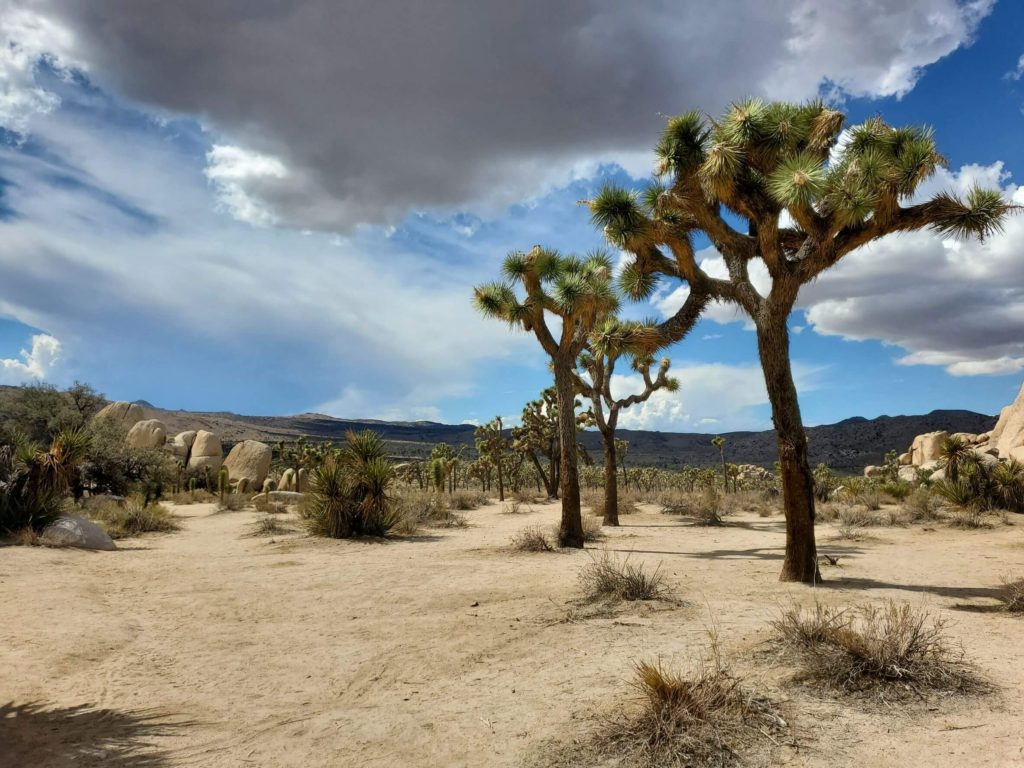
After entering Joshua Tree National Park through the western entrance station, you will drive for a few miles before you come to any development.
Once you start seeing signs for things like trails and picnic areas, you’ll begin your drive through Hidden Valley.
Hidden Valley is one of the best places for seeing Joshua trees.
Although Hidden Valley refers to a general area in the park, there are several specific places you can stop to park. If you want to get out of your car for pictures, try stopping at a roadside pullout or head to the Hidden Valley picnic area.
Barker Dam

If you have time to take a stroll through Joshua Trees, check out the trail to Barker Dam. You’ll need to take a slight detour off Park Boulevard onto Barker Dam Road to access this trail.
This one-mile loop trail is one of the most popular trails in Joshua Tree National Park.
There are a good number of Joshua trees along the trail. You’ll also see Barker Dam, a rare spot where you may find water in Joshua Tree National Park depending on the time of year you visit.
Although this hike is only about a mile long, expect to spend about an hour on this trail. There are lots of informational signs to read along the way.
Cap Rock

Cap Rock is the first of several fun rock formations you’ll see on your drive through Joshua Tree National Park.
This is a large pile of rocks with a smaller rock on top that looks like a cap sitting on top of the rock pile.
You’ll find it at the intersection of Park Boulevard and Keys View Road. Turn onto Keys View Road to access the parking area for Cap Rock.
There’s a short nature trail here if you want to stretch your legs, learn more about the ecosystem, or just see Cap Rock from a few different angles.
Skull Rock

Skull Rock is another cool rock formation along Park Boulevard.
It’s a large rock with indentations that make it look like a human skull.
Skull Rock is best viewed from its side since it doesn’t necessarily look like a skull from all angles. You’ll want to get out of your car to see it properly, but luckily you don’t have to walk far from your car to a good viewing point.
You can see sunrise from Skull Rock, but afternoon shadows accentuate the skull-like features better.
Sights to See Along Pinto Basin Road
As you drive through Joshua Tree National Park, you’ll eventually come to an intersection where you can stay on Park Boulevard or turn onto Pinto Basin Road. Driving along Pinto Basin Road will let you experience a different side of the park. You’ll see more interesting rock formations but also discover unique vegetation in the Colorado Desert.
Arch Rock
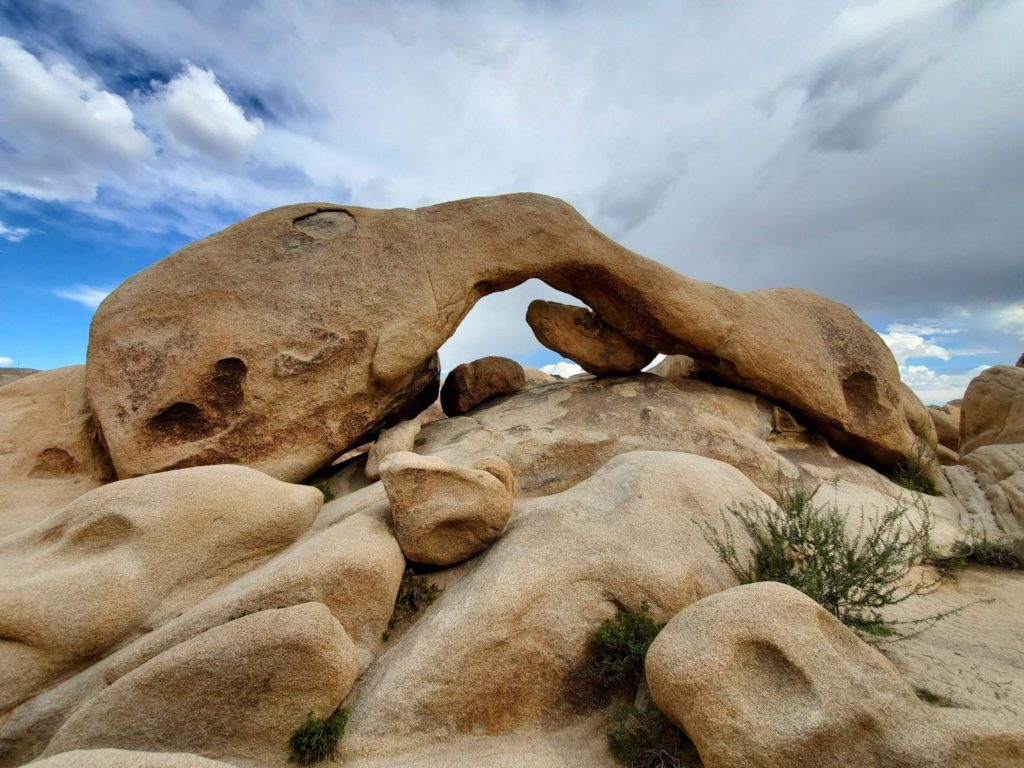
Even if you plan to skip Pinto Basin Road and exit the park through the northern entrance, consider taking a detour to see Arch Rock before you leave.
Arch Rock has been shaped into an arch by geologic processes over time. It makes for a great photo op at the very least but it’s also neat to climb around and on the rocks.
Getting to Arch Rock takes hiking a little over a mile roundtrip on a flat trail. If you’re only going to do one hike in Joshua Tree National Park, I would choose this one.
Heart Rock
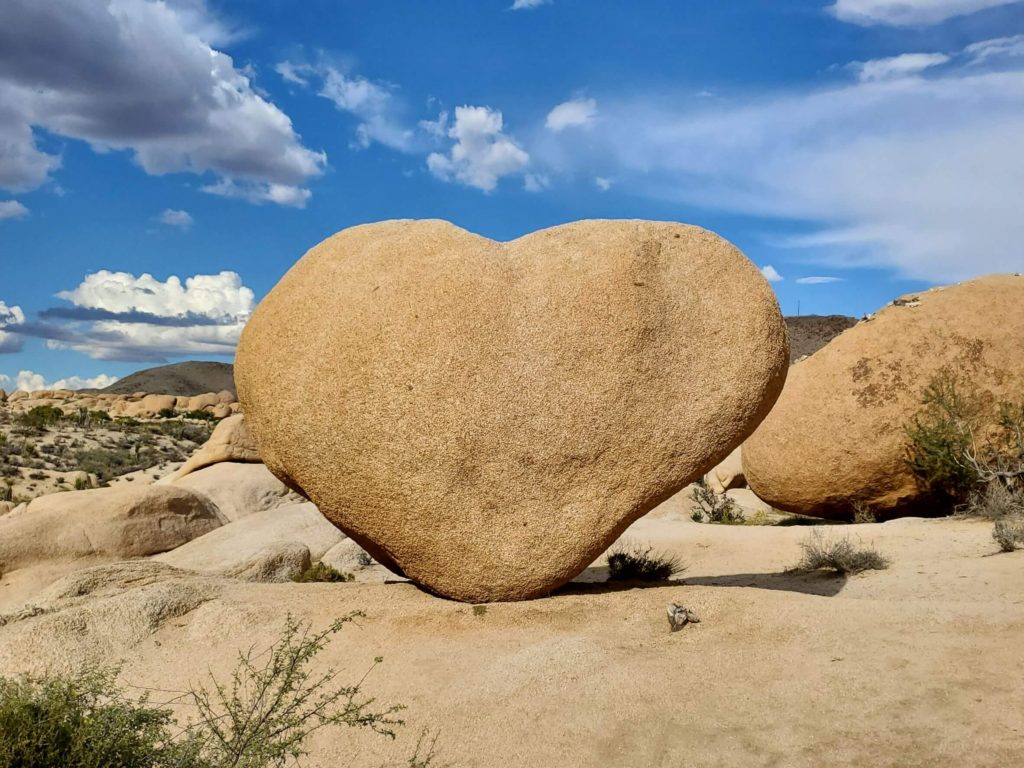
While you’re at Arch Rock, take the marked side path that leads to Heart Rock. This is partly why I recommend taking the hike to Arch Rock over other hikes in Joshua Tree – you can see two cool features on one trail!
Heart Rock is – you guessed it – shaped like a heart. How cute is that?
You may have seen Heart Rock before since it’s a popular spot to post on Instagram.
Walking to Heart Rock adds less than half a mile onto your hike to Arch Rock.
Cholla Cactus Garden

The Cholla Cactus Garden is an area filled with cholla cacti.
A short trail loops through the cacti so you can walk through this cactus garden.
Just be careful walking around the cholla cacti, especially if you’re with children, because these spiky cacti can attach to you easily and get stuck in your feet and clothes.
This is a popular area to watch sunrise and sunset because the cactus spikes look like they’re glowing in the sun when the light streams through.
Ocotillo Patch
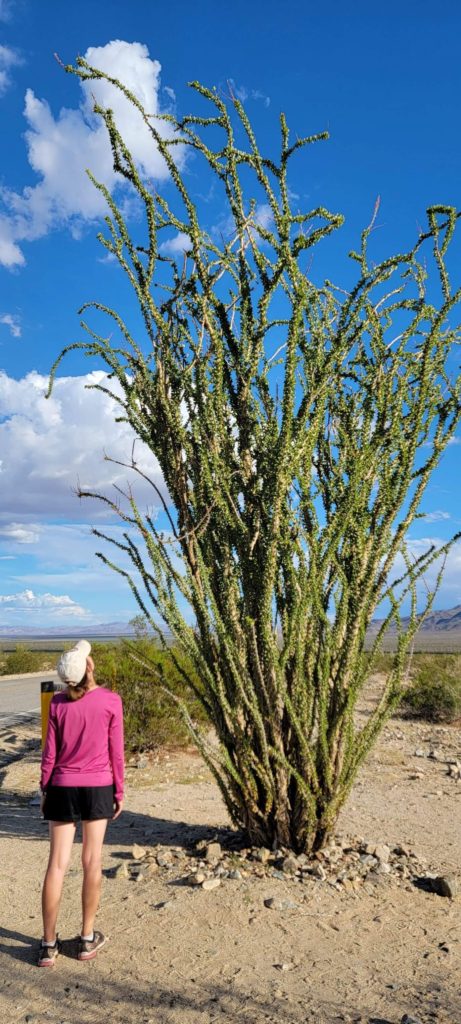
The last stop that I recommend taking on your drive along Pinto Basin Road is the ocotillo patch.
What looks like it might be a succulent is actually a deciduous shrub. Depending on when you visit, the ocotillo may have small red blossoms at its ends.
After the ocotillo patch you still have a decent way to drive before reaching the southern entrance of the park. Although there aren’t many designated attractions to stop at on the rest of the drive, it’s still interesting to look out at the landscape of the Colorado Desert as you navigate through the park.
Need more help planning your trip to Joshua Tree National Park? Check out these related articles:
- Stargazing In Joshua Tree National Park: Complete Guide For Beginners
- The Best Campgrounds In (And Near) Joshua Tree National Park
- How To Plan A National Park Trip: 7 Tips For A Perfect Visit
As always, enjoy the outdoors responsibly. Leave no trace on all of your adventures.
